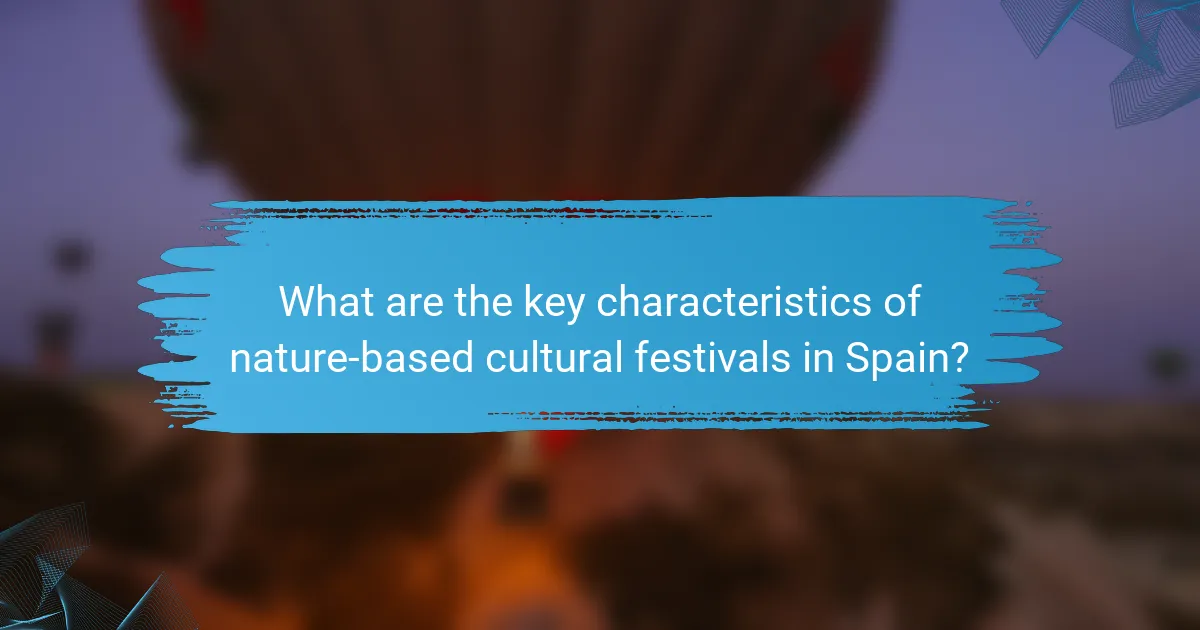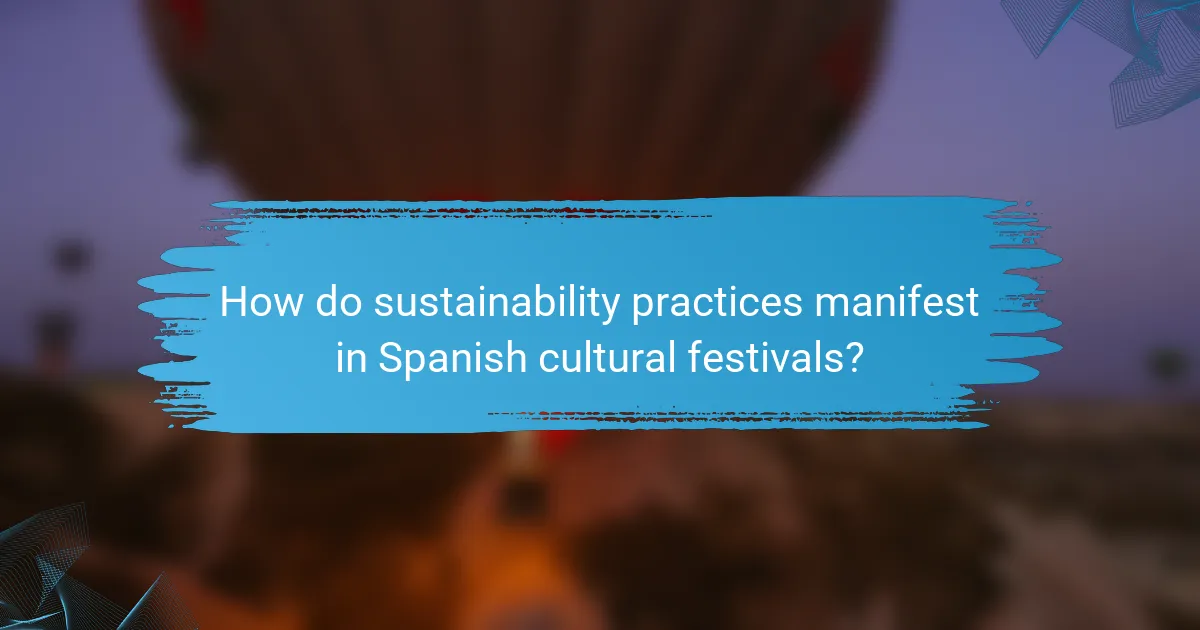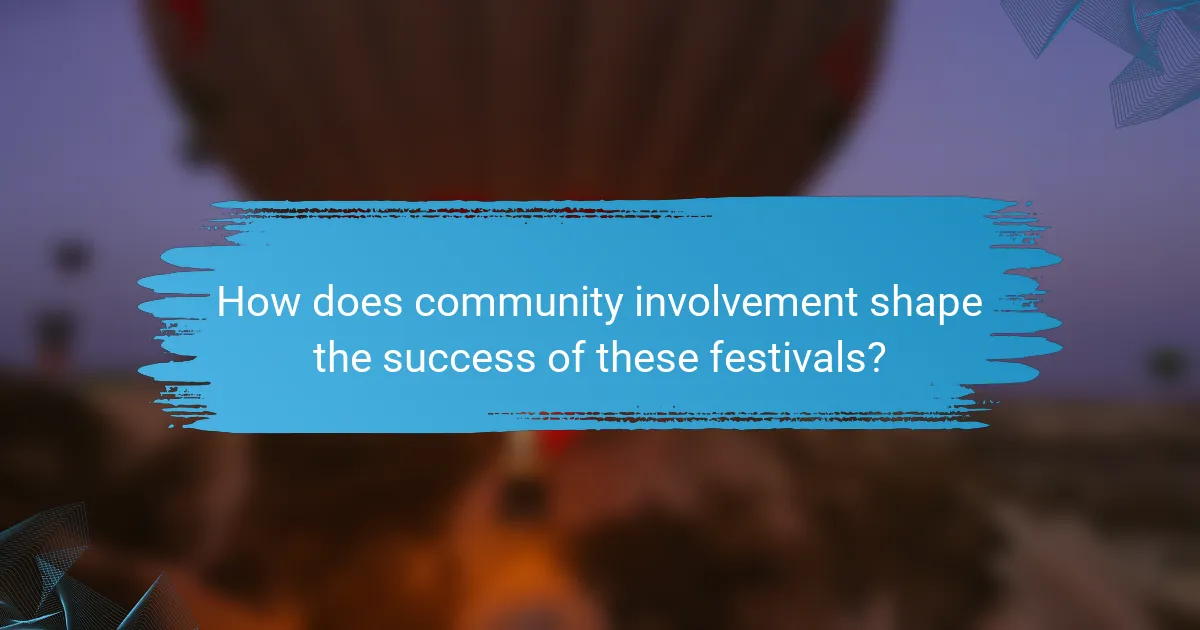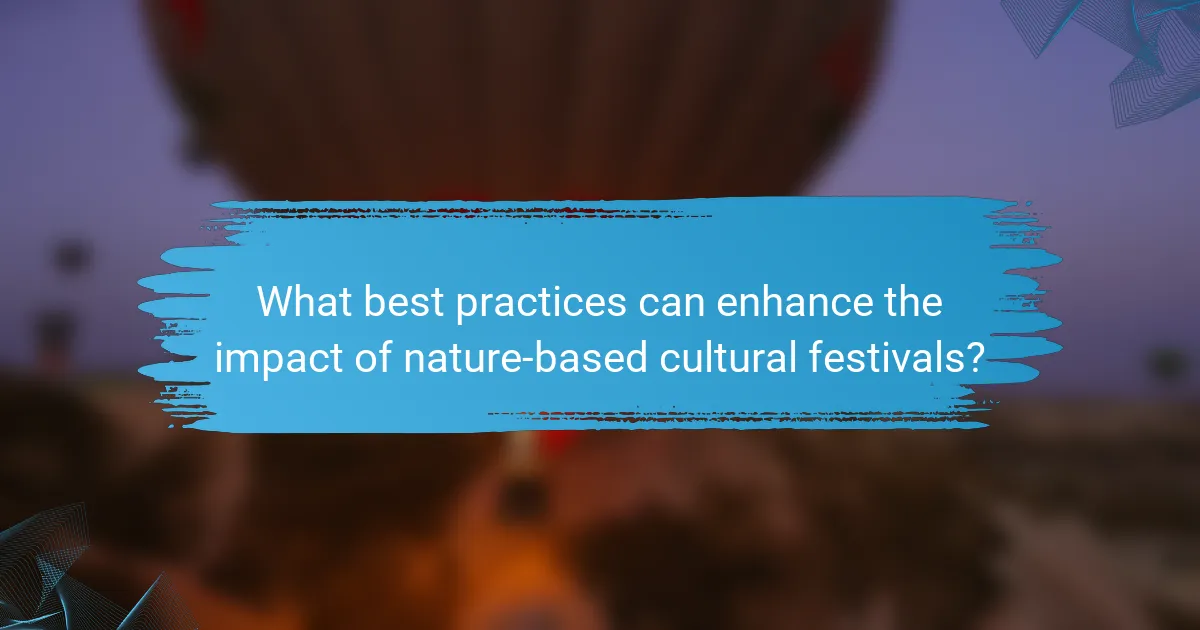Nature-based cultural festivals in Spain offer a unique blend of community involvement, sustainability practices, and the celebration of local traditions. These events highlight regional flora and fauna while promoting environmental awareness through eco-friendly initiatives. Festivals like La Tomatina and the Fallas showcase local agriculture and artistic expressions, emphasising the importance of community engagement. Challenges such as funding and balancing tradition with modern sustainability demands are also addressed.

What are the key characteristics of nature-based cultural festivals in Spain?
Nature-based cultural festivals in Spain emphasise community involvement, sustainability practices, and the celebration of local traditions. These festivals often incorporate natural elements, showcasing regional flora and fauna. They promote environmental awareness through eco-friendly practices like waste reduction and sustainable sourcing. Community participation is vital, as locals contribute to organising events and preserving cultural heritage. Unique attributes include traditional music, dance, and artisanal crafts that reflect the region’s identity. These festivals foster a sense of belonging and pride among participants, enhancing social cohesion.
How do these festivals reflect local traditions and heritage?
Nature-based cultural festivals in Spain showcase local traditions and heritage through vibrant celebrations that emphasise community involvement and sustainability. These festivals often incorporate traditional music, dance, and culinary practices that reflect the region’s history. For instance, the Fallas festival in Valencia features elaborate sculptures, representing local craftsmanship and artistic expression. Additionally, many festivals promote environmental awareness by integrating eco-friendly practices, such as waste reduction and the use of local materials. This fusion of cultural expression and sustainability reinforces community bonds and preserves unique regional identities.
What role does the natural environment play in these celebrations?
The natural environment is central to nature-based cultural festivals in Spain, enhancing traditions and sustainability practices. These celebrations often reflect local ecology, utilising native plants and landscapes. For example, festivals like La Tomatina and Las Fallas engage communities in environmental stewardship, promoting awareness of ecological issues. As a result, these events foster a sense of belonging and responsibility towards nature.

How do sustainability practices manifest in Spanish cultural festivals?
Sustainability practices in Spanish cultural festivals often prioritise environmental conservation, community engagement, and local resources. Festivals like La Tomatina and Feria de Abril incorporate recycling programs, promote local food sourcing, and encourage traditional crafts. These practices foster awareness of ecological issues while preserving cultural heritage. For example, in the Festival de San Juan, bonfires use sustainably sourced wood, minimising environmental impact. Such initiatives enhance community involvement and strengthen cultural identity.
Which eco-friendly initiatives are commonly implemented?
Common eco-friendly initiatives in nature-based cultural festivals in Spain include waste reduction, local sourcing, and biodiversity promotion. These practices enhance sustainability and community engagement.
1. Waste reduction: Implementation of recycling stations and composting initiatives.
2. Local sourcing: Encouragement of local artisans and food producers to minimise carbon footprints.
3. Biodiversity promotion: Activities focused on protecting local flora and fauna.
4. Educational workshops: Sessions on sustainability practices for attendees.
5. Carbon offset programs: Initiatives to balance emissions through tree planting or renewable energy projects.
How do festivals promote biodiversity and conservation awareness?
Nature-based cultural festivals in Spain promote biodiversity and conservation awareness by engaging communities and showcasing sustainable practices. These festivals highlight local ecosystems, encouraging participants to appreciate and protect their natural surroundings. For example, events often feature workshops on traditional farming techniques, which emphasise biodiversity conservation. Additionally, festivals foster a sense of community involvement, as local residents collaborate in organising activities that celebrate their cultural heritage while promoting environmental stewardship. Through these initiatives, festivals serve as platforms for education and advocacy, raising awareness about the importance of preserving biodiversity.

What are the unique cultural festivals that highlight nature in specific regions?
Spain hosts unique cultural festivals that celebrate nature, emphasising traditions, sustainability, and community engagement. Festivals like La Tomatina in Buñol highlight local agriculture, while the Fallas in Valencia showcases artistic expressions using natural materials. The Fiesta de la Primavera in Córdoba features floral displays that honour the region’s botanical heritage. Additionally, the Festival of the Sea in Galicia promotes marine conservation through local seafood traditions. Each festival reflects a commitment to preserving natural resources and fostering community spirit.
Which festivals incorporate indigenous practices and beliefs?
Nature-based cultural festivals in Spain often incorporate indigenous practices and beliefs, reflecting local heritage. Festivals like the Fiesta de la Primavera in Valencia celebrate seasonal changes with traditional rituals. The Romería del Rocío involves pilgrimage and communal worship rooted in local spirituality. The Fiestas de San Juan feature bonfires symbolising purification, aligning with ancient customs. Lastly, the Festival de la Luz in Galicia emphasises connection to nature through light and fire, showcasing indigenous reverence for the environment.
How do local festivals differ in their environmental themes?
Local festivals in Spain vary significantly in their environmental themes, focusing on sustainability and community engagement. Some festivals prioritise traditional ecological practices, while others emphasise modern sustainability initiatives. For instance, the Festival of San Juan promotes beach clean-ups, whereas the Fiestas de la Primavera incorporates local flora in its decorations. Community involvement is a common thread, with many festivals encouraging local participation in eco-friendly activities. Ultimately, these festivals reflect diverse approaches to environmental consciousness, showcasing unique attributes tied to regional cultures and traditions.

How does community involvement shape the success of these festivals?
Community involvement is crucial for the success of nature-based cultural festivals in Spain. Engaged locals enhance festival authenticity and foster cultural preservation. Their participation boosts attendance, ensuring financial viability and sustainability. Moreover, community-driven initiatives often lead to innovative practices that align with environmental goals. For instance, local volunteers may implement waste reduction strategies, enriching the festival’s ecological footprint. Ultimately, strong community ties create a sense of ownership, driving the festival’s long-term success and relevance.
What are the benefits of local participation in festival planning and execution?
Local participation in festival planning enhances community connection and cultural preservation. Engaging locals fosters ownership, ensuring traditions are authentically represented. It promotes sustainability practices by integrating local resources and knowledge. Furthermore, collaboration boosts economic benefits, as local vendors gain visibility and support. Active involvement also strengthens social ties, creating a sense of belonging and pride among residents.
How do festivals foster community identity and cohesion?
Nature-based cultural festivals in Spain strengthen community identity and cohesion through shared traditions and sustainable practices. These festivals promote local culture, encourage participation, and foster connections among residents. For instance, events like La Tomatina and Las Fallas celebrate regional heritage while supporting environmental sustainability through waste reduction initiatives. Community involvement enhances social bonds, as residents collaborate in organising and participating in these festivities, creating a sense of belonging and pride. Consequently, these festivals serve as vital platforms for cultural expression and community solidarity.

What challenges do nature-based cultural festivals face in Spain?
Nature-based cultural festivals in Spain face several challenges, including environmental sustainability, funding issues, and community engagement. These festivals often struggle to balance traditional practices with modern sustainability demands. Additionally, securing financial support can be difficult, as many rely on sponsorships and government grants. Community involvement is crucial, yet it can be inconsistent, affecting participation and the overall success of events.
How do climate change and environmental degradation impact festival sustainability?
Climate change and environmental degradation significantly threaten festival sustainability by disrupting local ecosystems and diminishing resource availability. Festivals in Spain, which often rely on natural settings and community participation, face challenges such as increased weather volatility and biodiversity loss. For example, rising temperatures can affect attendance and alter traditional practices. Additionally, resource scarcity can strain waste management and energy use, forcing festivals to adapt or risk cancellation. Sustainable practices, such as waste reduction and eco-friendly initiatives, are essential for mitigating these impacts and preserving cultural heritage.
What are common logistical issues faced by festival organizers?
Festival organizers often face logistical issues such as inadequate transportation, insufficient waste management, and coordination challenges among vendors. These factors can hinder the smooth execution of nature-based cultural festivals in Spain. Additionally, weather unpredictability can disrupt planned activities, impacting attendance and engagement. Budget constraints may limit resources for sustainability practices, making it difficult to implement eco-friendly initiatives. Effective communication with the community is essential to mitigate these challenges and enhance participation.

What best practices can enhance the impact of nature-based cultural festivals?
To enhance the impact of nature-based cultural festivals, incorporate community participation, sustainable practices, and educational programs. Engaging local communities fosters ownership and pride, while sustainability reduces environmental impact. Educational initiatives raise awareness about cultural heritage and environmental conservation. These practices create memorable experiences that resonate with attendees.
How can festivals balance tradition and modern sustainability goals?
Festivals can balance tradition and modern sustainability goals by integrating eco-friendly practices while honouring cultural heritage. For instance, many nature-based cultural festivals in Spain have adopted waste reduction strategies and renewable energy sources. These initiatives not only preserve the environment but also enhance community involvement, fostering a sense of pride and responsibility. Engaging local artisans and promoting traditional crafts further solidifies the connection between cultural identity and sustainability efforts.
What strategies can improve community engagement and participation?
Utilising strategies that emphasise local traditions and sustainability can significantly enhance community engagement in nature-based cultural festivals in Spain. Encouraging participation through collaborative planning fosters a sense of ownership among community members.
Promoting educational workshops on sustainability practices can deepen understanding and involvement. Integrating local artists and artisans into festival activities showcases cultural heritage, attracting more participants.
Additionally, leveraging social media for outreach creates a platform for community dialogue and feedback. Establishing partnerships with local organisations can expand resources and increase visibility, further boosting engagement.
Finally, measuring participation rates and gathering feedback after each festival can help refine strategies for future events, ensuring continuous improvement and community involvement.